Events &
Packages Research
Packages Research
Padua and the "Da Carrara" family
|
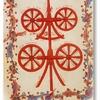 If for Padua, the Thirteenth century was the true and proper start of a new era, decisively marking the aspect of the medieval town, the Fourteenth century was a century of changing fortunes, with economic and territorial expansion, magnificent works of art and science, and the glory and the destruction of one of the most powerful dynasties of the century, that of the da Carrara. It lasted from 1318, the year that officially initiated the Carrarese Signory, until 1405, the date of their final defeat. The Cararras were a family endowed with an exuberant pride, greedy for power and richness, with a particular taste for the use of weapons and war as the solution to any dispute. However, they were also a family of enlightened patrons of culture, the arts and sciences, and in the entire territory of Padua they left significant, tangible and picturesque traces of their passionate history; but above all they promoted, in a astounding manner, the growth of figurative arts and scientific studies in the University of Padua. If for Padua, the Thirteenth century was the true and proper start of a new era, decisively marking the aspect of the medieval town, the Fourteenth century was a century of changing fortunes, with economic and territorial expansion, magnificent works of art and science, and the glory and the destruction of one of the most powerful dynasties of the century, that of the da Carrara. It lasted from 1318, the year that officially initiated the Carrarese Signory, until 1405, the date of their final defeat. The Cararras were a family endowed with an exuberant pride, greedy for power and richness, with a particular taste for the use of weapons and war as the solution to any dispute. However, they were also a family of enlightened patrons of culture, the arts and sciences, and in the entire territory of Padua they left significant, tangible and picturesque traces of their passionate history; but above all they promoted, in a astounding manner, the growth of figurative arts and scientific studies in the University of Padua.Arts and Culture at the Court Perhaps even before the other nearby courts of the Po valley, there developed in Padua the jargon known as the "court art", characterized by refined elegance and iconographic innovations linked to chivalry life, court life, or mythology. It was under the long rule of Francesco il Vecchio (lord from 1354 to 1388) that Padua reached its greatest splendour, witnessed by the myriad of ex
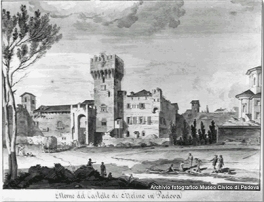 traordinary works of art due to the magnificence of Francesco I, and particularly to the passion for culture and the arts of his wife, Fina Buzzaccarini. The court of the da Carrara exerted fascination on artists and writers, was a breeding ground of works of art and intellectual fervour; it attracted poets, painters, sculptors, scientists, physicians and jurists. By the Fourteenth century Padua had developed into one of the most important cultural centres of northern Italy, influencing the main courts of North Europe. Extraordinary personalities like Guariento, Altichiero, Giusto de' Menabuoi, Andriolo de' Santi, and Francesco Petrarch, just to name a few, found protection and support at the Carraras court. traordinary works of art due to the magnificence of Francesco I, and particularly to the passion for culture and the arts of his wife, Fina Buzzaccarini. The court of the da Carrara exerted fascination on artists and writers, was a breeding ground of works of art and intellectual fervour; it attracted poets, painters, sculptors, scientists, physicians and jurists. By the Fourteenth century Padua had developed into one of the most important cultural centres of northern Italy, influencing the main courts of North Europe. Extraordinary personalities like Guariento, Altichiero, Giusto de' Menabuoi, Andriolo de' Santi, and Francesco Petrarch, just to name a few, found protection and support at the Carraras court.The Carraras and the University The da Carrara Lords protected the University without interfering with its autonomy and freedom. They promoted the influx of students from the whole of Europe and encouraged the best professors to teach in the Bo Palace, sponsoring their stay in Padua, inviting them to take part in their Chancellery, and treating them as family members. For their University in 1363, with a Bull by Pope Urban V, they obtained the department of Theology that until then had existed only at the Sorbonne and in Bologna. Francesco Petrarch and the Carraras "E tardi assai mi mossi e venni a Padova, ove da quell'eccelso, non qual si suole fra gli uomini, ma qual cred'io s'usa tra i beati del cielo, m'ebbi accoglienza di tanto gaudio, di tanto amore, di tenerezza tanta ripiena che non potendo a parole fra che altri l'intenda, miglior partito stimo il tacerne". (summary translation: And I moved very late to Padua where I was welcomed not as we are accustomed among people, but as the Blessed are welcomed, with such a joy, and love, and tenderness that my words cannot describe what I felt, and so I will not say one more word about this.) With these words Francesco Petrarch described his decision to move to Padua, drawn by the repeated requests of Giacomo II. It was, in fact, through the invitation of this member of the da Carrara family that Petrarch arrived at Padua, first in 1348, but officially in March, 1349, when he obtained the Canonicate Office of St. James at the Cathedral. This fact tied the poet to the city the rest of his life, where he undoubtedly felt at home in the fervid cultural climate of the Carrara Court, close to the learned university world, and to the not less scholarly Curia, where Petrarch became a close acquaintance with bishop Ildebrandino 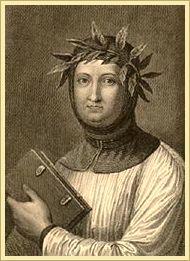 Conti, already known at the papal court in Avignon. The so-called pre-humanistic poets from Padua, Lovato de'Lovati, Rolando da Piazzola, Albertino Mussato, and Marsilio da Padova, had given impulse to the rediscovery of the classic world, exploring libraries and archives, and Petrarch continued their research for these antique works and could conduct his studies on ancient texts in serenity. For the continuous affectionate treatment of the poet by Giacomo II, Petrarch frequently praised his generosity and kindness, and wept bitterly when he received the news of the killing of his loved patron. Besides the arrival and the dissemination of new ideas, the presence of the poet in Padua stimulated distinguished personalities come to Padua with the desire to meet him. Among them was Giovanni Boccaccio, who arrived in Padua in 1351, and with whom Petrarch spent intense days of study and conversation. Francesco I, son and successor of Giacomo II, honoured the poet as much as his father and established a family relationship with him, who was held in great consideration as an advisor in diplomatic relations, and in addition he gifted him a house in Arquà, where the poet lived his last years together with his beloved daughter, his son-in-law and a few other persons. Here, he spent days in which he dedicated fully to his favourite activities: "Reading, writing, meditating are at present as they have been since my early childhood, my dearest pleasures". When death found him, between the 18th and 19th of July, 1374, according to tradition he was reclining his head on a manuscript by Virgil, in his study at late night. Conti, already known at the papal court in Avignon. The so-called pre-humanistic poets from Padua, Lovato de'Lovati, Rolando da Piazzola, Albertino Mussato, and Marsilio da Padova, had given impulse to the rediscovery of the classic world, exploring libraries and archives, and Petrarch continued their research for these antique works and could conduct his studies on ancient texts in serenity. For the continuous affectionate treatment of the poet by Giacomo II, Petrarch frequently praised his generosity and kindness, and wept bitterly when he received the news of the killing of his loved patron. Besides the arrival and the dissemination of new ideas, the presence of the poet in Padua stimulated distinguished personalities come to Padua with the desire to meet him. Among them was Giovanni Boccaccio, who arrived in Padua in 1351, and with whom Petrarch spent intense days of study and conversation. Francesco I, son and successor of Giacomo II, honoured the poet as much as his father and established a family relationship with him, who was held in great consideration as an advisor in diplomatic relations, and in addition he gifted him a house in Arquà, where the poet lived his last years together with his beloved daughter, his son-in-law and a few other persons. Here, he spent days in which he dedicated fully to his favourite activities: "Reading, writing, meditating are at present as they have been since my early childhood, my dearest pleasures". When death found him, between the 18th and 19th of July, 1374, according to tradition he was reclining his head on a manuscript by Virgil, in his study at late night.The Splendour of a Royal Palace The Royal Palace of the da Carrara family (Reggia Carrarese), the residence of the Lords of Padua, was built by Ubertino da Carrara starting from 1338 in the area close to the Cathedral. The Royal Palace, traces of which are today found incorporated in other monuments, imparted a new type of growth, modern and elegant, to the western part of the city. The newest architectural monument that opened onto loggias and courtyards was surrounded by high walls for a perimeter of about 600 metres, to form a true and proper island inside the town, the worthy residence destined to host the magnificent Carrara court. The grand complex of buildings also comprised the so-called "ferry" (traghetto), a long hanging corridor, three metres wide, supported by twenty-eight arches that connected the palace and the castle; it was demolished in 1777. This complex was immediately enriched with internal courtyards, gardens, and orchards, three large frescoed meeting rooms, and a series of service areas, including kitchens, offices, and rooms for the military guard corps. Today, of all of this magnificence little testimony is left: of the new palace there remains the Sala degli Uomini Illustri (the Hall of the Illustrious Men - known as Sala dei Giganti - the Hall of the Giants), which still preserves from that time only one, extremely precious fragment of a fresco representing Francesco Petrarch in his study. Of the old palace the only thing saved is the double portico, known as the Loggia, an elegant and refined example of 14th-century architecture, and some rooms with fragments of frescoes. On the fist floor of the Accademia, in what is today the Sala delle Adunanze (Assembly Hall) one can perceive, at least in part, the atmosphere of the private chapel of the Princes. The walls are decorated with frescos telling episodes from the Old Testament, made between 1349 and 1354 by Guariento, while the beautiful wooden tables with the angels' hierarchy that at one time decorated the ceiling completing the iconographic theme of the chapel, are preserved at the town museum of Musei Civici Eremitani.
The crest of Ubertino da Carrara The symbol of a Saracen wearing golden horns was chosen by Ubertino I da Carrara for his crest, and afterwards by Francesco I and Francesco II, too. The golden horns were supposedly added by Ubertino as a consequence of the infidelity of his wife with Alberto della Scala, while the golden wings are a symbol of the acquisition of imperial titles.
The Coat of Arms of the da Carrara family 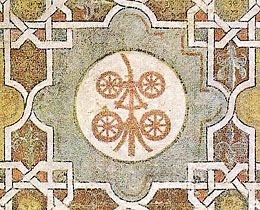 *Imperial sedendo fra più stelle / dal ciel dises' un carro d'onor degno / soto Signor d'ogn'altro più benegno. / Le rote soi guidavan quatro done, / Justicia e Temperancia cum Forteza / ed àn Prudenza tra cotanta alteza*. (summary translation: A cart descended the skies that was worth the greatest Lord. It was driven by four Ladies, Justice and Temperance, with Fortitude and Prudence) (madrigal set to music by fra' Bartolino da Padova). The cart, the emblem of the da Carrara family, under the rule of Francesco il Vecchio was interpreted as an allegory of the virtues that a good governor should have.
Situated on the north wall of the Eremitani Church this tomb, together with that of Ubertino da Carrara, was originally in St. Augustine's Church (destroyed in 1822). At the close deaths of the two da Carrara lords, the family commissioned the two sepulchral monuments to Andriolo de' Santi. The tomb of Jacopo II stands out for its columns in rose marble, the pictorial decoration performed by Guariento around 1351, and the eight elegiac couplets by Francesco Petrarch, friend of Jacopo II. Born at the beginning of the 14th century, Jacopo II seized the government of the city through force, killing the successor designated by Ubertino on 6 March, 1345. A lover of humanities, it was Jacopo who made the arrival of Francesco Petrarch in Padua possible, with the collaboration of bishop Ildebrandino Conti. He was stabbed to death out of envy and jealousy on 19 December, 1350 by a distant relative, Guglielmo da Carrara, who was in turn immediately massacred.
The Tomb of Giacomo II The tomb of UbertinoPlaced exactly facing the tomb of Jacopo II, the tomb of Ubertino is composed by an arcosolium and a hanging tomb held up by brackets, on which was lain the figure of the defunct in civilian clothes. The arcosolium is chiselled along the borders with refined vegetable motives, which in the underside of the arch alternate with half busts of Saints and two figures of angels, in the pendentives. Th
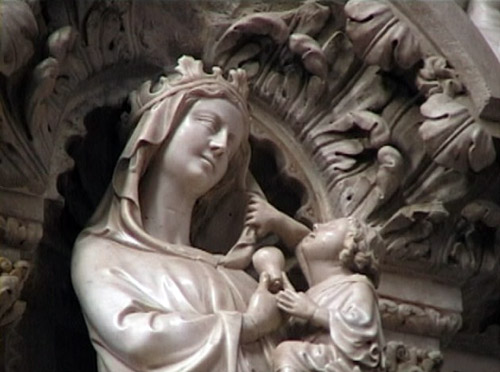 e real sarcophagus features a Madonna with Child, while along the frame angels are carved. Ubertino, considered the first true lord of Padua, insured peace and prosperity in Padua through alliance with Venice, in open contrast with the della Scala family ruling in Verona; he promoted numerous building improvements, among which the construction of the royal palace, promoted industry and commerce, favoured learning by conferring new privileges to the University. Not having legitimate children, two days before dying he appointed Marsilietto Papafava as his heir, who however was killed upon order of Jacopo II after just 41 days of governing. e real sarcophagus features a Madonna with Child, while along the frame angels are carved. Ubertino, considered the first true lord of Padua, insured peace and prosperity in Padua through alliance with Venice, in open contrast with the della Scala family ruling in Verona; he promoted numerous building improvements, among which the construction of the royal palace, promoted industry and commerce, favoured learning by conferring new privileges to the University. Not having legitimate children, two days before dying he appointed Marsilietto Papafava as his heir, who however was killed upon order of Jacopo II after just 41 days of governing.
|
